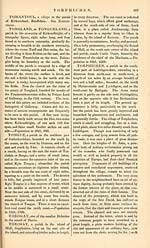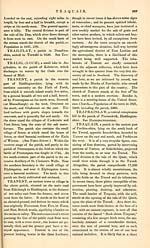Gazetteer of Scotland > Volume 2
(510) Page 988
Download files
Complete book:
Individual page:
Thumbnail gallery: Grid view | List view

TORTHORWALD.
of the parish of Torphichen. What remains
of the old building does not indicate either a
very large or a very beautiful structure, though
the four pillars which support the choir or
central tower are rather fine, and the Gothic
window of the southern transept still exhibits
a sort of haggard grace. In the interior of the
choir is shown the monument of Walter Lind-
say, the second last preceptor, who died in
1538. The last of the preceptors, who
held the office at the Reformation, was one of
the Sandilands family, in whose favour the
lands were erected into a temporal lordship,
with the title of Torphichen. The baptismal
font is also still shown within the walls of the
choir, as also a strangely ornamented recess
underneath the window already mentioned,
said to have been the place where the bodies
of the dead were deposited during the perfor-
mance of the funeral service. The steeple,
or belfry, to which there is an ascent by a nar-
row spiral stair, is now used in the respectable
capacity of a dovecot. The preceptory of
Torphichen, like some other religious build-
ings, not only could give protection to fugitive
criminals within its sacred walls, but had a
precinct possessed of the same privilege. The
sanctuary of Torphichen extended a mile in
every direction around the church. There
still exists in the churchyard, near the west
end of the present place of worship, a stone,
like an ordinary mile-stone, with a cross carved
upon its top, which marked the centre of the
sanctuary ; and a similar mark is said to have
been placed at each of the four extremities
corresponding with the cardinal points. Debtors
flying from their creditors, or criminals seek-
ing refuge from private resentment or from
justice, were alike safe when they got within
the circle described by these four stones. —
Population of the village and parish in 1821,
1197.
TORRISDALE, a river in Sutherland-
shire, which rises from Loch Laoghal, betwixt
the parishes of Tongue and Farr, and after
running in a northerly course, falls into the sea
at the village of Torrisdale, where there is an
indentation of the sea called Torrisdale Bay.
The river is otherwise named the water of
Borgie.
TORRY,a small fishing village with a small
harbour and pier, in the county of Kincardine,
near Girdleness.
TORRYBURN, a parish at the south-
west corner of Fife, formed by the union of
the baronies of Torry and Oombie, at the be-
ginning, as is supposed, of the seventeenth cen-
tury. It extends along the shore of the Firth
of Forth, betwixt the parish of Dunfermline
on the east, and that of Culross on the west,
and measures from four to five miles in length,
by about two in breadth. The land is gene-
rally cultivated and fertile. West from Crom-
bie-point, a promontory on the Firth, stands
the village of Torryburn, at the distance of
nine miles west from North Queensferry, and
two east of Culross. Betwixt it and Culross,
within the boundary of the parish, is the vil-
lage of Newmills Population in 1821, 1443.
TORTHORWALD, a parish near the
foot of Nithsdale, Dumfries- shire, bounded by
Tinwald on the north, by Lochmaben and
Mousewald on the east, and separated on the
west from Dumfries by the Lochar water. It
extends six miles in length from north to south,
by a breadth at the northern extremity of about
two and a-half miles, tapering to a point on the
south. The southern part of the district com-
poses part of the extensive swampy and mea-
dow land, called Lochar Moss. On the north
the land is arable ; and here is situated the vil-
lage of Torthorwald, with the ruins of the an-
cient castle of Torthorwald in its vicinity,
which is supposed to have existed since the
thirteenth century : it was at one period the resi-
dence of a natural son of the Earl of Morton,
created Lord Torthorwald by James VI., about
the year 1590. On the road from Torthorwald
to Dumfries stands the village of Roucan —
Population in 1821, 1205.
TORWOOD, a forest in Stirlingshire, in
the parishes of Larbert and Dunipace, noted
for having afforded shelter to Sir William Wal-
lace after his defeat in the north, and for being
the scene of some military exploits during the
war of independence. The forest is now great-
ly limited and decayed.
TOUGH, a parish in Aberdeenshire, hav-
ing Keig on the north, Monymusk and Cluny
on the east, Lumphanau on the south, and
Leochel and iUl'ord on the west, extending five
miles in length, and three in breadth. The
surface is irregular, but the rising grounds are
mostly arable — Population in 1821, 698.
TOWIE, a parish in Aberdeenshire, bound-
ed by Kildrummy on the north, Glenbucket,
part of Migvie, and Logie-Coldstone on the
west, by the latter on the t,outh, and Cushnieand
of the parish of Torphichen. What remains
of the old building does not indicate either a
very large or a very beautiful structure, though
the four pillars which support the choir or
central tower are rather fine, and the Gothic
window of the southern transept still exhibits
a sort of haggard grace. In the interior of the
choir is shown the monument of Walter Lind-
say, the second last preceptor, who died in
1538. The last of the preceptors, who
held the office at the Reformation, was one of
the Sandilands family, in whose favour the
lands were erected into a temporal lordship,
with the title of Torphichen. The baptismal
font is also still shown within the walls of the
choir, as also a strangely ornamented recess
underneath the window already mentioned,
said to have been the place where the bodies
of the dead were deposited during the perfor-
mance of the funeral service. The steeple,
or belfry, to which there is an ascent by a nar-
row spiral stair, is now used in the respectable
capacity of a dovecot. The preceptory of
Torphichen, like some other religious build-
ings, not only could give protection to fugitive
criminals within its sacred walls, but had a
precinct possessed of the same privilege. The
sanctuary of Torphichen extended a mile in
every direction around the church. There
still exists in the churchyard, near the west
end of the present place of worship, a stone,
like an ordinary mile-stone, with a cross carved
upon its top, which marked the centre of the
sanctuary ; and a similar mark is said to have
been placed at each of the four extremities
corresponding with the cardinal points. Debtors
flying from their creditors, or criminals seek-
ing refuge from private resentment or from
justice, were alike safe when they got within
the circle described by these four stones. —
Population of the village and parish in 1821,
1197.
TORRISDALE, a river in Sutherland-
shire, which rises from Loch Laoghal, betwixt
the parishes of Tongue and Farr, and after
running in a northerly course, falls into the sea
at the village of Torrisdale, where there is an
indentation of the sea called Torrisdale Bay.
The river is otherwise named the water of
Borgie.
TORRY,a small fishing village with a small
harbour and pier, in the county of Kincardine,
near Girdleness.
TORRYBURN, a parish at the south-
west corner of Fife, formed by the union of
the baronies of Torry and Oombie, at the be-
ginning, as is supposed, of the seventeenth cen-
tury. It extends along the shore of the Firth
of Forth, betwixt the parish of Dunfermline
on the east, and that of Culross on the west,
and measures from four to five miles in length,
by about two in breadth. The land is gene-
rally cultivated and fertile. West from Crom-
bie-point, a promontory on the Firth, stands
the village of Torryburn, at the distance of
nine miles west from North Queensferry, and
two east of Culross. Betwixt it and Culross,
within the boundary of the parish, is the vil-
lage of Newmills Population in 1821, 1443.
TORTHORWALD, a parish near the
foot of Nithsdale, Dumfries- shire, bounded by
Tinwald on the north, by Lochmaben and
Mousewald on the east, and separated on the
west from Dumfries by the Lochar water. It
extends six miles in length from north to south,
by a breadth at the northern extremity of about
two and a-half miles, tapering to a point on the
south. The southern part of the district com-
poses part of the extensive swampy and mea-
dow land, called Lochar Moss. On the north
the land is arable ; and here is situated the vil-
lage of Torthorwald, with the ruins of the an-
cient castle of Torthorwald in its vicinity,
which is supposed to have existed since the
thirteenth century : it was at one period the resi-
dence of a natural son of the Earl of Morton,
created Lord Torthorwald by James VI., about
the year 1590. On the road from Torthorwald
to Dumfries stands the village of Roucan —
Population in 1821, 1205.
TORWOOD, a forest in Stirlingshire, in
the parishes of Larbert and Dunipace, noted
for having afforded shelter to Sir William Wal-
lace after his defeat in the north, and for being
the scene of some military exploits during the
war of independence. The forest is now great-
ly limited and decayed.
TOUGH, a parish in Aberdeenshire, hav-
ing Keig on the north, Monymusk and Cluny
on the east, Lumphanau on the south, and
Leochel and iUl'ord on the west, extending five
miles in length, and three in breadth. The
surface is irregular, but the rising grounds are
mostly arable — Population in 1821, 698.
TOWIE, a parish in Aberdeenshire, bound-
ed by Kildrummy on the north, Glenbucket,
part of Migvie, and Logie-Coldstone on the
west, by the latter on the t,outh, and Cushnieand
Set display mode to: Large image | Transcription
Images and transcriptions on this page, including medium image downloads, may be used under the Creative Commons Attribution 4.0 International Licence unless otherwise stated. ![]()
| Gazetteers of Scotland, 1803-1901 > Gazetteer of Scotland > Volume 2 > (510) Page 988 |
|---|
| Permanent URL | https://digital.nls.uk/97436942 |
|---|
| Description | Volume II: Glenbanchor to Zetland. |
|---|---|
| Attribution and copyright: |
|
| Description | By Robert Chambers and William Chambers. Glasgow: Blackie & Son, 1838. 2 volumes. |
|---|---|
| Shelfmark | NF.1461.g.7 |
| Additional NLS resources: | |

